Mental
Following the Local Government Act, 1888, West Ham became a County Borough on 1st April 1889. As one of its first acts, the councillors decided that the new Borough should have its own asylum for mentally ill paupers rather than continue to use the Essex County Asylum in Brentwood.
Eventually a site was chosen and in 1895 the Blue House Farm, to the north of Ilford, was acquired for £8,835, with sanction to a loan for £7,360 being obtained for this purpose. A further sanction was obtained in 1898 to borrow £300,000 for the erected of the buildings.
The foundation stone was laid on 3rd August 1898 by Alderman William Ivey, and work began on the building of the Asylum, which was to accommodate 800 patients.
The West Ham Borough Asylum officially opened on 1st August 1901. It had cost £338,633 to design and build.
Built on a Compact Arrow layout, with a south-facing aspect, the central Administrative Block was flanked on either side with four ward pavilions, one designated for the sick and infirm, another for acute cases, one for epileptic patients and the last for chronic cases. The west side contained 350 beds in 8 wards for male patients, and the east side 450 beds in 9 wards for female patients. There was also an isolation block.
The site also contained a kitchen, a mortuary, workshops, staff quarters, a laundry and farm buildings. An artesian well had been sunk to provide a water supply, and the necessary pumping plant and water tower had also been built.
Residences for the staff, located to the east of the Asylum along Barley Lane, included a Medical Superintendent's house (now Tantallon House), a Steward's house, two detached cottages for the Resident Medical Officers, and four pairs of semi-detached cottages for married attendants (which had to be supplemented in 1907 by another three pairs).
The Asylum farm, located to the south of the site, provided produce for the institution and an occupation for the inmates.
The first patients were admitted on 6th August 1901, having been transferred from the Essex County Asylum.
The chapel opened in 1902, built in the same style as the Asylum. It could seat 600 people.
In 1908 the Borough Council extended the Asylum by purchasing the neighbouring Heath House and its 12-acre estate at Little Heath, following the death of its owner, Major G.E. Ibbetson. The house was altered and extended, and became Little Heath House with accommodation for 70 female patients. It had cost £3,444. (It was later separated from the main Asylum when an arterial road - Eastern Avenue - was built in the 1920s. It was taken over by the Essex County Council as a Public Assistance Institution for the chronically sick.)In 1918 the Asylum was renamed the West Ham Mental Hospital.
As the need for more patient accommodation grew, in 1925 Hargreaves Farm was purchased with a view to extend the Hospital to the north. In the meantime, the laundry was improved and the telephone system, heating system and electrical wiring were upgraded.
In 1928 plans were drawn up to extend the Hospital to the north by an additional 417 beds and tenders were invited for the new buildings in two sections.
The first contract was for 2- and 3-storey buildings:
- Five detached villa blocks (3 for male and 2 for female patients), each to accommodate 45 patients, with Day and Dining Rooms on the ground floor and dormitories on the first floor, with the necessary sanitary annexes.
- Two convalescent blocks (one for male and one for female patients), with 15 beds in each. Day Rooms were on the ground floor and small dormitories of 3 to 4 beds each on the first floor.
- A 3-storey Nurses' Home adjoining Barley Lane to provide accommodation for 10 doctors, 72 nurses, 5 maids and quarters for the Home Sister and Sister Tutor. Recreation, Reading and Dining Rooms and a kitchen were on the ground floor.
- Two Admission Blocks, one for 30 male and one for 25 female patients, each with a Day Room and a dormitory, and some single rooms for patients under observation. Each had an annexe for clinics and hydrotherapy.
- A Kitchen Block was attached to these, with rooms for nurses and Lecture Rooms above.
- A Medical Block, which was located near the main drive and connected to the Admission Blocks by a covered way. It contained rooms for X-ray examination, ultraviolet ray and electrical treatments and dental treatment.
The extensions were opened on 5th February 1934 by the Mayor, Alderman H.J. Runsey, who was also Chairman of the Hospital. The new Admission Building at the southeast contained two wards - Hunter and Gregory Wards. Two single-storey blocks - containing Linden and Lavender Wards - at the southwest were for semi-infirm patients. The new villas were also named after trees or shrubs - Magnolia, Hawthorn and Acacia for the male ones and Rosemary and Lilac for the female. Together with the male convalescent villa (Cherrytree) and the female one (Somerville), they formed an arc north of the main Hospital buildings.
A new house had been built on Barley Lane for the Superintendent, and his original one converted into patient accommodation.
In addition, operating theatres with anaesthetic and recovery rooms had been provided in the main Hospital, as well as two large waiting rooms - each measuring 20 x 61 ft (6 by 19 metres) for patients' visitors. The existing blocks for chronic patients on each side had been altered to provide additional dormitories and Day Room space, as well as a room in the administrative portion for the Assistant Medical Officer. A small 2-bedded isolation block for female nurses had been arranged adjacent to the female Sick and Infirm Block.
The boiler house and laundry blocks had been extended, and an additional artesian well had been sunk to the depth of 415 ft (127 metres). Its pump was capable of pumping 12,000 gallons of water per hour up to the main tank in the water tower.
The cost of the work was £229,000 and it had raised the bed complement of the Hospital to 1,300.
During the 1930s newer treatments were introduced at the Hospital, including insulin coma in 1937.
During WW2 the Hospital joined the Emergency Medical Scheme. Four of its wards were converted into an Emergency Base Hospital (where, by the end of the war, some 8,000 patients had received treatment). Its former annexe at Little Heath House also became part of the Emergency Medical Scheme.
As it was geographically along the line for enemy bombers heading towards London, the Hospital was affected by a number of bombs falling nearby. The most extensive damage was caused by a bomb demolishing one of the villas.
In 1948 the Hospital joined the NHS under the control of the Goodmayes Mental Hospital Management Committee, part of the North East Metropolitan Regional Hospital Board. It had 1,178 beds and was renamed Goodmayes Hospital. Its catchment area was altered to accommodate more of the surrounding area and to link services with Warley Hospital (the former Essex County Asylum). Laundry services for the group were centralised at the Hospital.
During the 1950s the Hospital began to operate an 'open-ward' policy, whereby wards were left unlocked for 8 hours or more a day so that patients had free access to the grounds. Only two wards remained 'locked', that is, secure for 24 hours a day.
An Industrial Therapy Unit was also established, aimed at the rehabilitation of chronic patients who had become institutionalised. Its purpose was to enable them to acquire work discipline and experience and be gainfully employed so that they could eventually be discharged and resettled in a community. Government policy dictated that Hospitals should not longer run farms as, apart from other factors, increased mechanisation had made such an occupation dangerous to those who did not know how to use the machinery properly.
In 1956 the Hospital had 1,356 beds, reduced to 1,331 in the following year.
As new drug treatments became available during the 1960s the need for in-patient care lessened. Those admitted stayed for shorter periods of time.
In January 1969 a psychogeriatric unit was established because of the increasing demand for hospital care of patients aged over 65 years with dementia.
Following a major reorganisation of the NHS in 1974, the Hospital transferred to the Redbridge and Waltham Forest Area Health Authority, under the control of the East Roding District Health Authority, part of the North East Thames Regional Health Authority.
In 1975 the Hospital had 1,087 beds.
In the mid 1970s the Brookside Young People's Unit was established to provide psychiatric care for adolescents aged from 13 to 18 years. It had 20 beds and 4 classrooms.
In 1982, after another major reorganisation of the NHS, the Hospital came under the administration of the Redbridge District Health Authority. It had 781 beds. The laundry services for the District were centralised at the Hospital and the laundry buildings extended later, with a new main storeroom being built north of the boiler house.
In 1989 the Hospital had 674 beds.
In the early 1990s the NHS underwent a more radical reorganisation, with the introduction of the health trust system. The Hospital joined the Redbridge Health Care Trust in 1993 with 452 beds.
By this time plans to relocate the King George Hospital in Eastern Avenue to the Goodmayes Hospital site were well underway. The ward blocks built in the early 1930s had been demolished, as had the isolation block and the mortuary. (The new King George Hospital opened in 1993.)
In 1996 the Pathways on Tagore Psychiatric Intensive Care Unit, opened with 14 beds for the treatment of patients with short-term illness. In 1997 the Brookside Unit was extended. In 1998 the East Forest Unit, an 18-bed admission unit, was opened to provide in-patient care for adults from the Waltham Forest catchment area. The Hospital then had 273 beds, which increased to 410 in 1999.
In 2001 the Meadow Court nursing home opened, replacing the nearby Chadwell Heath Hospital. Built on the site of the female chronic and epileptic ward blocks on the east of the site, it had 70 beds - 34 for frail elderly patients and 36 for those with dementia - and was managed by Care UK, a health care provider independent of the NHS.
In 2002 Chapters House was completed on the site of the former Admissions Block. The 2-storey building had 107 beds - 62 for adults with acute mental illness, 30 for elderly mentally ill patients and 15 for psychiatric intensive care - all in single rooms with en-suite facilities.
Present status (April 2008)
The Hospital site is still currently in use, with the laundry, water tower and boiler house providing services also for King George Hospital.
The original Administration Building and the Medical Superintendent's house (Tantallon House) are used for mental health purposes. The Hospital has 70 beds.
The 1934 Medical Superintendent's residence, the lodge cottage and The ward blocks for semi-infirm patients are no longer in use.
The chapel has been demolished and its site is now a car park.
Update: April 2013
The Hospital is now managed by the North East London NHS Foundation Trust.
In September 2008 The Willows Unit, a new 4-bed adolescent high dependency unit, opened on the Brookside site, which had also been extensively altered.
In November 2008 the Victor Hugo Assessment and Treatment Unit for adults with a learning disability and mental illness opened in Chapters House. It contains a sensory room.
In September 2009 work began on a new £23m mental health facility to replace the existing patient accommodation.
The new buildings, named Sunflowers Court, opened in January 2011. They contain 91 beds in five wards, one of which is a low secure unit with 15 beds and another a detox unit with 16 beds. The remaining three wards have 20 beds each - one ward each for acute male, acute female patients and a mixed-sex ward for the elderly. The wards are incorporated into a 2-storey building along with a central hub to provide shared facilities.
The Hospital now consists of Chapters House and Sunflowers Court on the "Goodmayes Hospital campus" - it is unclear if the name 'Goodmayes Hospital' will be retained. It is probably the intention of the Trust to sell the original buildings, now redundant, for housing redevelopment.
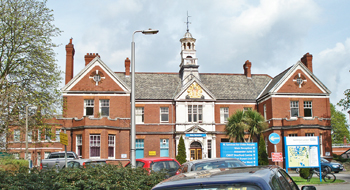
The Administration Block and the remaining buildings of the original Asylum are locally listed.
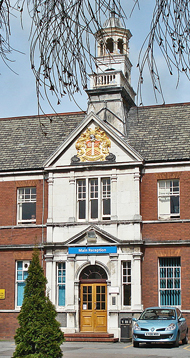
The gable above the main entrance bears the coat-of-arms of West Ham County Borough, with the motto Deo confidimus (we trust in God).
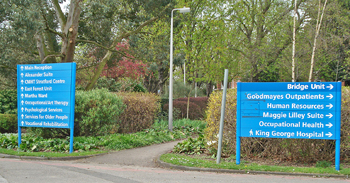
Signage near the entrance to the various departments.
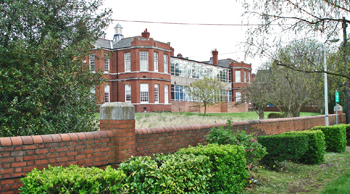
A ward block on the western side with glassed-in balconies.
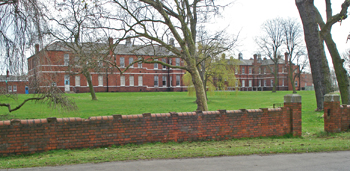
Ward blocks (above and below).
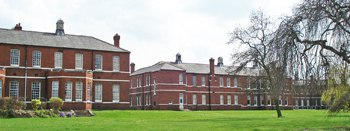
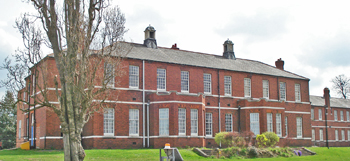
A ward block on the northwestern side.
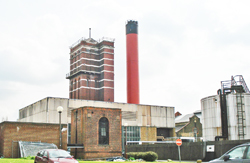
The water tower and boiler house are shared with the King George Hospital.
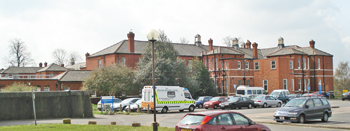
One of the northern ward blocks, as seen from the car park at King George Hospital.


Little Heath House, bought as an extension to the Asylum in 1908, has been demolished. Its site is now occupied by St James Gardens.
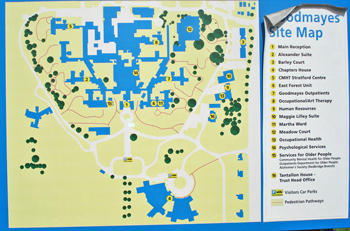
The site map shows the 'Compact Arrow' layout of the original Asylum buildings. Chapters House is shown at the south of the site.
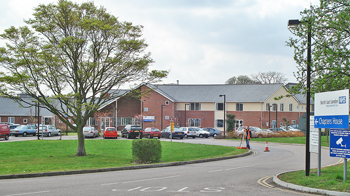
Chapters House, built in 2002, contains modern wards.
Larkin EH 1977 Insulin shock treatment of schizophrenia. British Medical Journal 1 (3979), 745-747.
http://edithsstreets.blogspot.co.uk
http://hansard.millbanksystems.com (1)
http://hansard.millbanksystems.com (2)
www.adakertrantor.co.uk
www.bailygarner.co.uk
www.british-history.ac.uk
www.devereuxarchitects.com
www.ilfordrecorder.co.uk
www.nelft.nhs.uk
www.pastscape.org.uk
www.studymore.co.uk
www.thetimechamber.co.uk
www2.redbridge.gov.uk
Return to home page